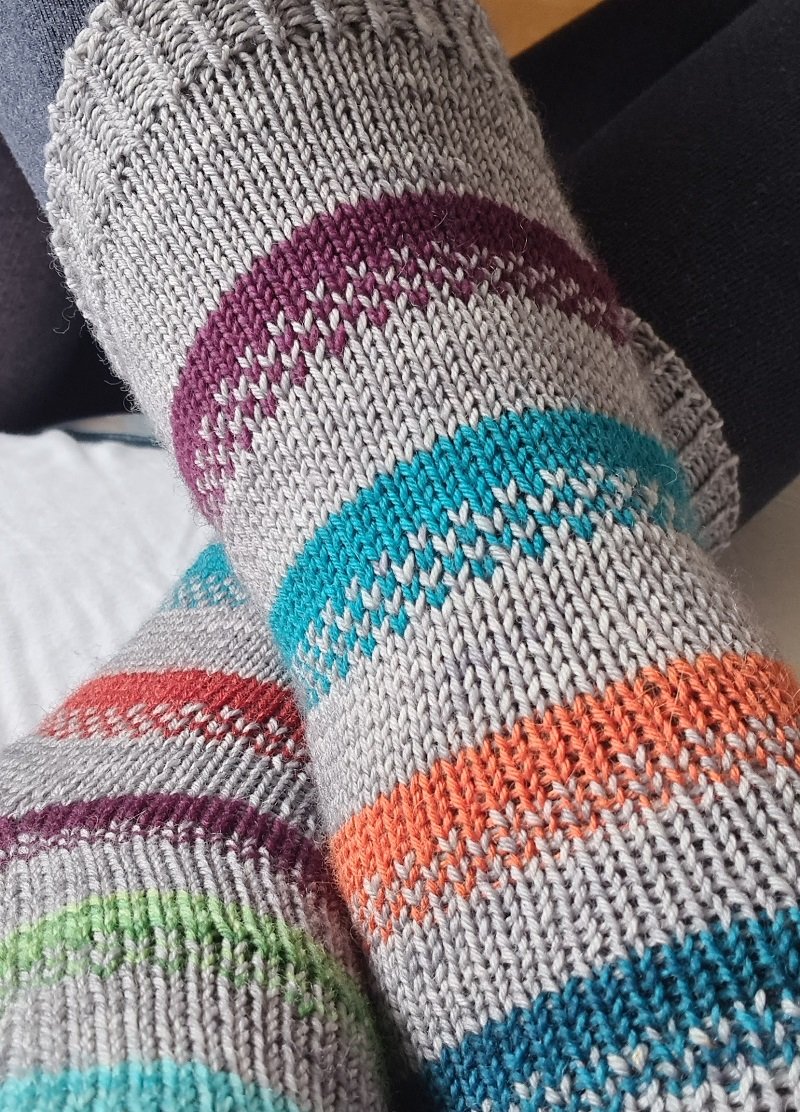So which is the best way to knit socks - cuff down or toe-up. As with most things in life, as well as in knitting, the answer is: It depends.
It depends on what you want to achieve, who you are knitting for and the style of sock that you are knitting also comes into play. Both ways of knitting socks have their pros and cons.
Cuff down socks: These are often suggested as the way to start your sock knitting journey for a variety of reasons but it does mean that you have to navigate the twisty cuff and couple of inches of ribbing first before you can settle into the good plain knitting section of the leg. To avoid the dreaded instruction ‘join to knit in the round, being careful not to twist’, I have a handy tip for that.
That being said, it is very easy to estimate the leg length when you are working this way and it works for a variety of heel types. Once past the heel you can pull the sock on as needed to check the foot length and decide where to start the toe decreases. An obvious disadvantage for some is the need to graft the toe closed (not everyone’s favourite procedure) although you can get around this by knitting a rounded toe (for example).
Gift knitting - if knitting socks for others I tend to opt for cuff down purely because it’s a little bit easier to get a reliable length for the foot. There are standard foot length charts available and that tell you exactly when to start decreasing for the toe. When working toe-up there is always the slight element of chance - depending on the kind of heel you are working.
Toe-up socks: It’s often said that it’s easier to try on socks that are knitted toe-up although I have to say that I’ve never had any particular issues trying on socks whichever direction they are knitted in. Toe-up socks certainly offer a faster start and there are very few things as satisfying in my knitted life as sitting down with fresh needles and yarn, and 30 minutes later having a fully functional sock toe and several inches of happy plain knitting ahead of me.
For this reason I often start a sock toe-up as it lends itself well to travel knitting and other times when you want to knit on the go. I’ve even started a toe-up sock in the cinema before now - although I wouldn’t recommend it. I’ve been known to have a sock toe, on the needles stashed around the house in case I need to grab a quick, travel friendly project in a hurry. You never know when you might need it and there’s no harm in being prepared…right?
There is sometimes concern over when to start the heel for toe-up socks and a common mistake that people make is to have the foot too big - ie starting the heel turn too late. When deciding where to start the heel it’s always best to bear in mind that socks need a little negative ease for a good fit and so slightly stretching the sock (whether on a sock ruler on your foot) is needed to make sure that you get that all important negative ease. My advice is always to slightly stretch the foot, and then stretch it a tiny bit more. It’s very unscientific I grant you but it works for me. THIS blog post has some tips that can help.
Working toe-up, of course means that there is no tricksy grafting and once you’ve worked the leg it’s just a bit of ribbing and you’re done. As long as you make sure not to cast off too tightly then you should have a perfectly lovely sock, ready to wear.
At the end of the day, it’s horses for courses. Some people will swear by one direction rather than another but it’s what you are happy with that counts. It’s always best to be able to work both ways - just in case as these skills are never lost. And in most cases, even if you are a devoted cuff down knitter and you inadvertently buy a toe-up pattern, it’s possible to convert a sock design to your preferred method. There are only a few directional patterns that in all honesty will only work one way.
So which are you - cuff down or toe-up? Or are you happy to knit in each direction - a sock ambivert perhaps?
PIN FOR LATER:



